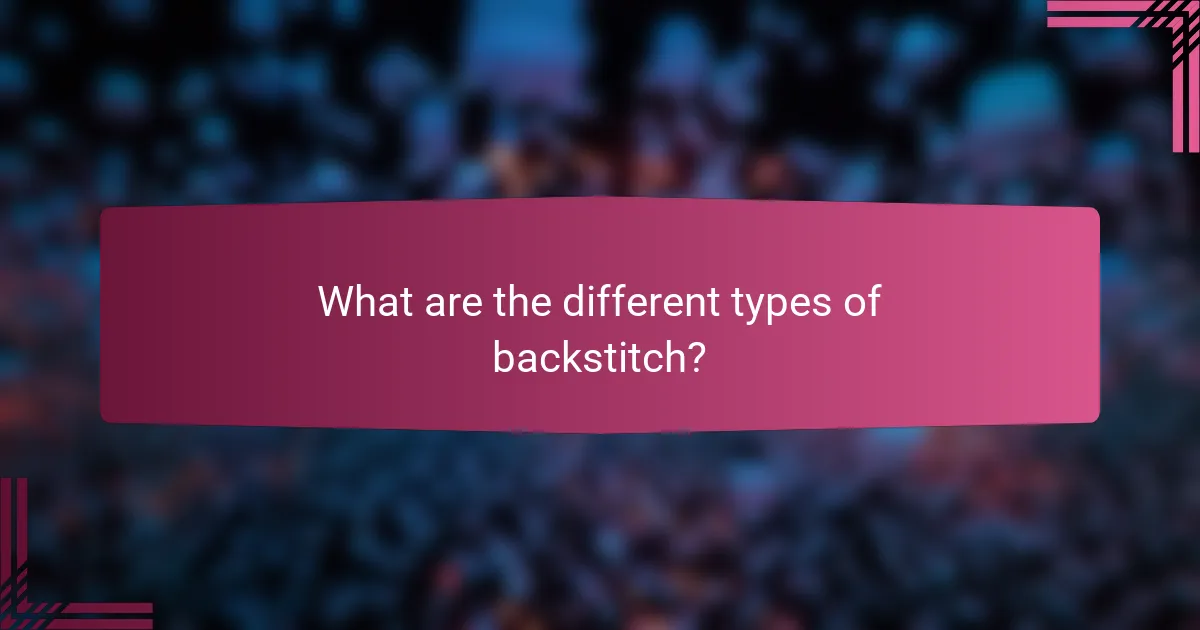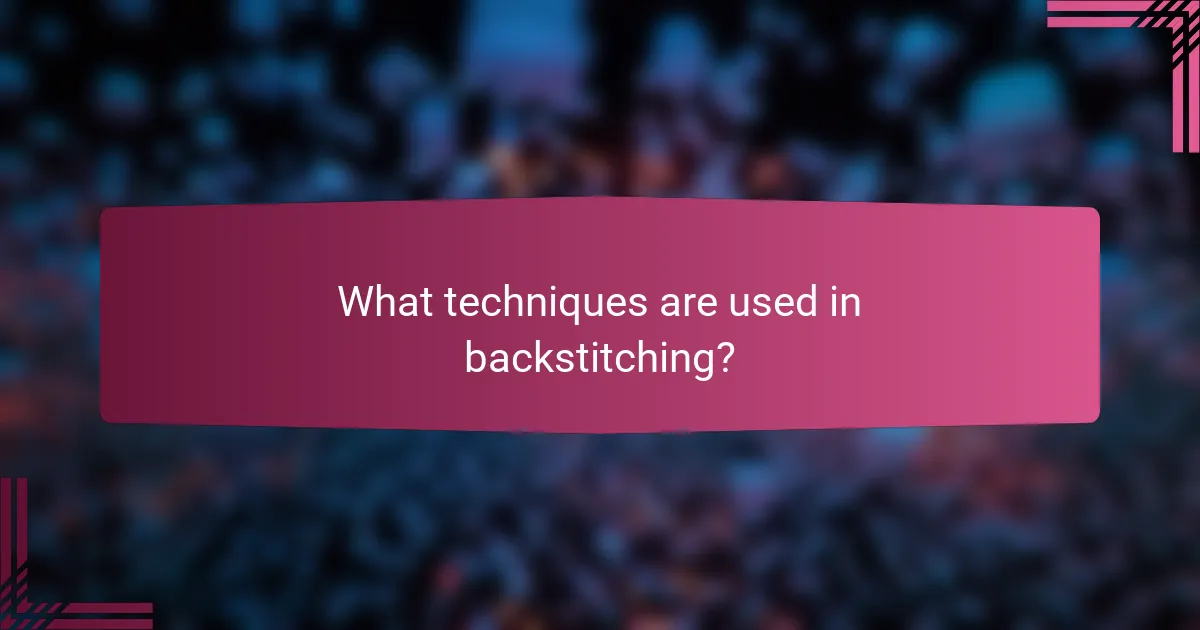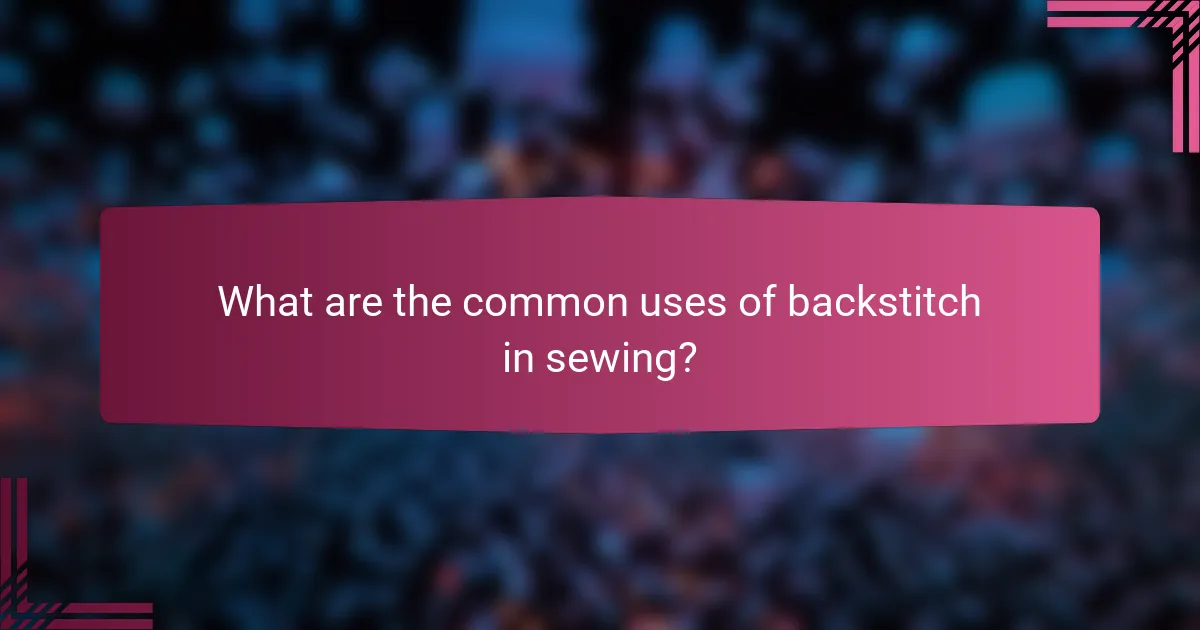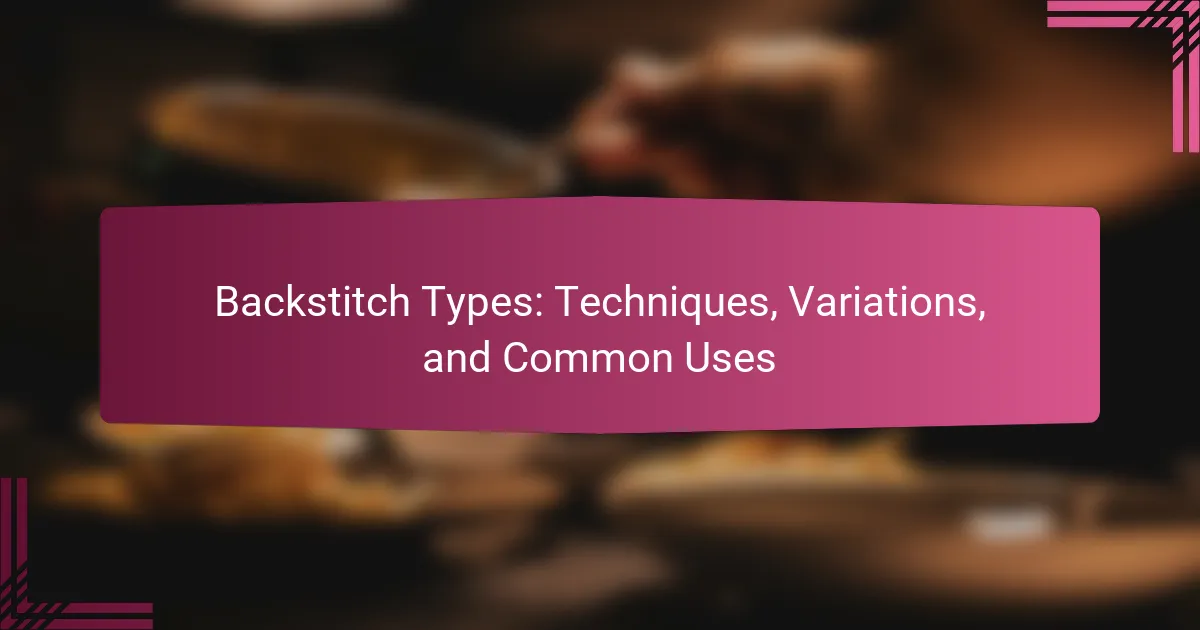
What are the different types of backstitch?
The different types of backstitch include standard backstitch, double backstitch, and split backstitch. Standard backstitch is the most common type used for outlining. It creates a solid line of stitching. Double backstitch is a variation that reinforces the stitch by going over it twice. This provides added durability. Split backstitch involves splitting the thread to create a textured effect. It is often used for decorative purposes. Each type serves unique functions in embroidery and sewing projects.
How do various backstitch types differ from one another?
Various backstitch types differ primarily in their application and appearance. The standard backstitch creates a solid line and is often used for outlining. The split backstitch provides a more textured line by splitting the thread on the return stitch. The double backstitch offers extra strength and thickness, making it suitable for areas that require durability. The backstitch with variations, such as decorative or raised backstitch, introduces unique visual elements. Each type serves different purposes in embroidery, affecting the overall design and finish. Understanding these differences helps in selecting the appropriate stitch for specific projects.
What are the characteristics of each backstitch type?
There are several types of backstitch, each with unique characteristics. The standard backstitch creates a solid line of stitching. It is often used for outlining and detailing. The double backstitch provides extra strength and durability. It is commonly used in areas that experience wear. The split backstitch allows for more flexibility in stitching. It is ideal for curved lines and intricate designs. The backstitch with a loop adds texture and dimension. It is often used in decorative embroidery. Each type serves specific purposes and can enhance the overall appearance of the work.
In what contexts are different backstitch types used?
Different backstitch types are used in various sewing and embroidery contexts. Traditional backstitch is commonly used for outlining and adding detail to designs. It provides strong, durable seams in garment construction. Variations like the double backstitch offer extra strength, making it suitable for heavy fabrics. The split backstitch is effective for creating fine lines in detailed embroidery work. Each type serves distinct purposes, enhancing both aesthetics and functionality in textile projects.
Why is it important to understand backstitch types?
Understanding backstitch types is crucial for effective sewing techniques. Different backstitch types offer varied strengths and appearances. Knowledge of these types allows for better selection based on fabric and project requirements. For example, a stronger backstitch is essential for heavy fabrics. Conversely, a delicate backstitch may be preferred for lightweight materials. Mastery of backstitch types enhances overall sewing quality. It also aids in achieving specific design aesthetics. Familiarity with backstitch variations can improve efficiency and skill in sewing projects.
How do backstitch types affect the overall sewing project?
Backstitch types significantly influence the overall sewing project by determining the strength and appearance of seams. Different backstitch techniques, such as the regular backstitch, double backstitch, and reinforced backstitch, offer varying levels of durability. For instance, a double backstitch provides extra strength, making it ideal for high-stress areas. Conversely, a standard backstitch is suitable for lightweight fabrics where flexibility is required. The choice of backstitch also affects the project’s aesthetic; a neat, even backstitch enhances the visual appeal of the finished item. Additionally, the stitch length and spacing can impact fabric gathering and overall drape. Therefore, selecting the appropriate backstitch type is crucial for achieving desired results in both functionality and style.
What common mistakes can be avoided by knowing backstitch types?
Knowing backstitch types helps avoid several common mistakes. One mistake is using the wrong stitch type for the fabric. Different fabrics require specific backstitch techniques to ensure durability and appearance. Another mistake is inconsistent stitch length. Understanding backstitch types promotes uniformity in stitch length, enhancing the final look. A third mistake is improper tension. Knowing the correct backstitch type aids in maintaining appropriate thread tension, preventing puckering. Additionally, misalignment of stitches can occur. Familiarity with backstitch variations helps in aligning stitches correctly, resulting in a neater finish. Lastly, beginners often overlook the importance of planning stitch direction. Understanding backstitch types allows for strategic stitching, improving efficiency and aesthetics.

What techniques are used in backstitching?
Backstitching techniques include the traditional backstitch, double backstitch, and decorative backstitch. The traditional backstitch involves creating a stitch by inserting the needle into the fabric and then bringing it back to the previous stitch’s end. The double backstitch adds an extra layer of security by stitching over the original backstitch. Decorative backstitching uses varied patterns to enhance visual appeal. These techniques improve seam strength and create detailed designs. Each technique serves specific purposes in sewing and embroidery, making them versatile for various projects.
How can mastering backstitch techniques improve sewing skills?
Mastering backstitch techniques can significantly enhance sewing skills. Backstitch provides a strong and durable seam, making it ideal for various fabrics. This technique improves precision in stitching, which is crucial for professional-looking results. It allows for better control over fabric manipulation during sewing. Additionally, mastering this technique can increase efficiency in completing sewing projects. Many experienced sewists recommend backstitch for its versatility in both hand and machine sewing. By practicing backstitch, sewists can also develop a deeper understanding of fabric behavior. This foundational skill sets the stage for more advanced sewing techniques.
What are the fundamental techniques involved in backstitching?
Backstitching involves a series of fundamental techniques. The primary technique is creating a stitch that goes backward into the previous stitch. This ensures a strong and secure seam. Another technique is maintaining consistent spacing between stitches for uniformity. The backstitch can be executed in a straight line or curved path, depending on the design. It is essential to keep tension even while stitching to prevent puckering. Additionally, using a needle appropriate for the fabric type enhances the stitch quality. These techniques are widely used in hand embroidery and sewing for durability.
How do advanced techniques enhance the quality of backstitching?
Advanced techniques enhance the quality of backstitching by improving precision and consistency. Techniques such as using specialized tools ensure even tension throughout the stitch. Enhanced thread selection allows for better durability and appearance. Techniques like double backstitching increase the strength of the seam. Advanced methods also include using templates for accurate spacing. These innovations lead to a more professional finish. Research indicates that structured approaches reduce common stitching errors. Overall, these techniques significantly elevate the craftsmanship of backstitching.
What tools are essential for effective backstitching?
Essential tools for effective backstitching include a needle, thread, and fabric. A sharp needle allows for easy [censured] through the fabric. Thread should be strong and appropriate for the material being stitched. Fabric must be stable to support the stitching process. Additionally, scissors are necessary for trimming thread. A thimble can protect fingers while pushing the needle through tougher materials. These tools collectively ensure clean and precise backstitching results.
Which tools are best suited for different backstitch techniques?
Embroidery needles, embroidery floss, and fabric are best suited for different backstitch techniques. Embroidery needles have a sharp point and a larger eye to accommodate multiple strands of floss. This allows for smooth stitching and minimizes fabric damage. Embroidery floss, typically made of six strands, can be separated for varying thickness in backstitching. Fabric choice impacts the stitch’s appearance; cotton or linen works well for clear lines. Specific tools like a thimble can help push the needle through thick fabric. Scissors are essential for trimming excess floss. These tools collectively enhance the effectiveness of backstitch techniques.
How do tools influence the execution of backstitch techniques?
Tools significantly influence the execution of backstitch techniques by determining precision and ease of use. The type of needle affects the fabric’s interaction during stitching. A sharp needle creates clean holes, allowing for smoother stitching. Thread choice also impacts the technique; thicker threads require larger needles and can alter the stitch’s appearance.
Specialized tools like embroidery hoops stabilize fabric, ensuring even tension. This stability allows for more consistent stitch lengths. Scissors designed for fabric can provide cleaner thread ends, preventing fraying. Additionally, ergonomic tools reduce hand fatigue, enhancing the stitcher’s control and accuracy.
Overall, the right tools enhance the quality and efficiency of backstitch techniques, leading to better finished projects.

What are the common uses of backstitch in sewing?
Backstitch is commonly used in sewing for creating strong seams. It provides durability in areas that experience stress, such as armholes and crotch seams. Backstitch is also effective for hemming and finishing edges. It can be used in hand-sewing techniques for mending and repairs. This stitch is favored for its ability to create a neat, straight line. Additionally, backstitch is utilized in embroidery for outlining designs. Its versatility makes it a fundamental technique in various sewing projects.
How is backstitch utilized in various sewing projects?
Backstitch is utilized in various sewing projects for its strength and durability. This technique creates a solid seam by stitching backward and forward, ensuring the thread secures tightly. It is commonly used in hand sewing for repairs, as it can withstand tension. Backstitch is also effective for sewing seams on heavier fabrics, such as denim and canvas. Additionally, it is employed in embroidery to outline designs due to its clean finish. This method is preferred in quilting for joining layers securely. In garment construction, backstitch reinforces areas that experience stress, like armholes and waistbands. The versatility of backstitch makes it a fundamental technique in both hand and machine sewing.
What types of fabrics are best suited for backstitching?
Cotton and linen fabrics are best suited for backstitching. These fabrics provide stability and ease of handling during stitching. They have a medium weight that supports the technique effectively. Additionally, they allow for clear visibility of the stitches. Fabrics with a tight weave, like canvas, also work well. They prevent fraying and maintain stitch definition. Stretchy fabrics, such as knits, are less suitable for backstitching. They can distort and complicate the stitching process. Choosing the right fabric enhances the quality of the backstitching outcome.
How does backstitching improve the durability of seams?
Backstitching improves the durability of seams by reinforcing the stitching at critical points. This technique involves sewing backward over the previous stitches. It creates a stronger hold by interlocking the threads. The additional stitching prevents unraveling under stress. Backstitching is particularly effective in high-stress areas like armholes and crotches. Research indicates that seams with backstitching exhibit higher tensile strength. This makes garments more resilient to wear and tear. Overall, backstitching is essential for enhancing seam longevity.
What tips can enhance the effectiveness of backstitching?
To enhance the effectiveness of backstitching, use a consistent tension on the thread. Maintaining even tension prevents puckering and ensures a smooth finish. Choose the right needle size for your fabric type to avoid damage. A sharp needle penetrates fabric easily, leading to cleaner stitches. Mark your stitching lines clearly to guide your backstitching accurately. This reduces errors and enhances overall precision. Practice on scrap fabric before working on the final piece. This builds confidence and improves technique. Lastly, regularly check your stitches as you go to catch mistakes early. This practice helps maintain high-quality results throughout your project.
How can proper technique improve the appearance of backstitching?
Proper technique can significantly enhance the appearance of backstitching. Utilizing consistent spacing between stitches ensures a uniform look. Maintaining even tension while stitching prevents puckering and distortion. Choosing the right needle and thread type can also impact the final outcome. For instance, a finer needle paired with appropriate thread results in cleaner lines. Additionally, practicing smooth, continuous movements leads to more precise stitches. Following these techniques can result in backstitching that is visually appealing and professionally executed.
What troubleshooting tips are available for common backstitching issues?
To troubleshoot common backstitching issues, check for thread tension problems. Adjust the tension if the stitches appear too loose or too tight. Ensure the needle is appropriate for the fabric type. A dull or damaged needle can cause skipped stitches. Verify that the fabric is not being pulled or pushed during stitching. This can lead to uneven stitches. Regularly clean the sewing machine to prevent lint buildup, which can affect performance. Lastly, practice consistent hand positioning for even stitch length.
The main entity of this article is backstitch, which is a fundamental sewing technique used to create strong seams and decorative designs. The article covers various types of backstitch, including standard, double, and split backstitch, detailing their unique characteristics, applications, and contexts of use. It emphasizes the importance of understanding these variations for effective sewing and embroidery, as well as the tools and techniques that enhance the quality of backstitching. Additionally, common mistakes and troubleshooting tips are provided to improve the overall effectiveness and appearance of backstitching in various projects.
